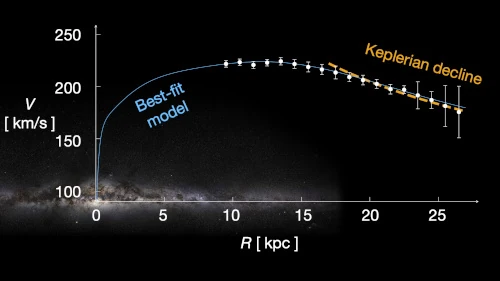
Image description: The rotation speed of the Milky Way is represented as a function of the distance from the galactic center. White dots and error bars represent measurements obtained from the Gaia DR3 catalog. The blue curve represents the best fit including ordinary matter and dark matter. The end of the curve in orange shows the Keplerian decay, which begins beyond the optical disk of our Galaxy indicating the absence of matter. © Jiao, Hammer et al. / Observatoire de Paris – PSL / CNRS / ESA / Gaia / ESO / S. Brunier
To measure the masses of galaxies we use a unit which corresponds to the mass of our Sun (M☉). Galaxies weigh between a few million solar masses and a few trillion solar masses.
Until now, the Milky Way was estimated to weigh about 1012 M☉. Part of this mass, made up of ordinary matter (stars, gas and dust), is estimated at approximately 0.6 x 1011 M☉. The rest of the Milky Way's mass, at least 6 times greater, is made up of dark matter, a hypothetical matter that is both invisible and sensitive to gravitation.
In the 1970s, Vera Rubin (1928-2016) showed that the rotation speed of stars on the outskirts of spiral galaxies remained constant, which did not correspond to the predictions of Newton's laws. The rotation curves should have followed a so-called “Keplerian” decay.
The direct consequence of this discovery was to propose the existence of dark matter, tirelessly sought after since.
According to a study published on September 27, 2023 in the European scientific journal “Astronomy and Astrophysics”, the mass of the Milky Way would be four to five times lower than the latest estimates.
The exact mass obtained from data in the Gaia DR3 catalog would be 2.06 x 1011 solar masses compared to 1012 previously. This study was carried out by astronomers from the Paris Observatory and the CNRS (France), Leroy, N., Martin, N. F., Wegg, C., et al. (2023).
The 2023 study takes into account the movements of 1.8 billion stars provided by the Gaia satellite with unprecedented precision. The rotation curve of the Milky Way clearly shows, with a probability of 99.7%, a Keplerian decay and not a constant rotation speed as previously.
Now many questions arise in cosmology!
Why do other large spiral galaxies not exhibit a rotation curve with a Keplerian decay?
Why would our galaxy be special?
Scientists have put forward two reasons:
- The Milky Way is a spiral galaxy that has experienced few disturbances linked to collisions between galaxies. The last one occurred about 9 billion years ago, when the dwarf galaxy SagDEG was absorbed by the Milky Way. The average for spiral galaxies is 6 billion years.
The Milky Way is located in the Local Group, a group of galaxies that includes about 50 galaxies. The Local Group is a relatively quiet region of the Universe, and collisions between galaxies are relatively rare there.
- The rotation curve of a galaxy is a graphical representation of the rotation speed of stars or gas as a function of their distance from the center of the galaxy. There is a big methodological difference between the new rotation curve of our Galaxy obtained from the movement of the stars (data delivered by the Gaia satellite), and the measurements made from neutral gas (hydrogen and helium) for the other galaxies. .
In conclusion, it is necessary to re-evaluate the rotation curves of large spiral galaxies and the quantities of ordinary matter compared to dark matter.